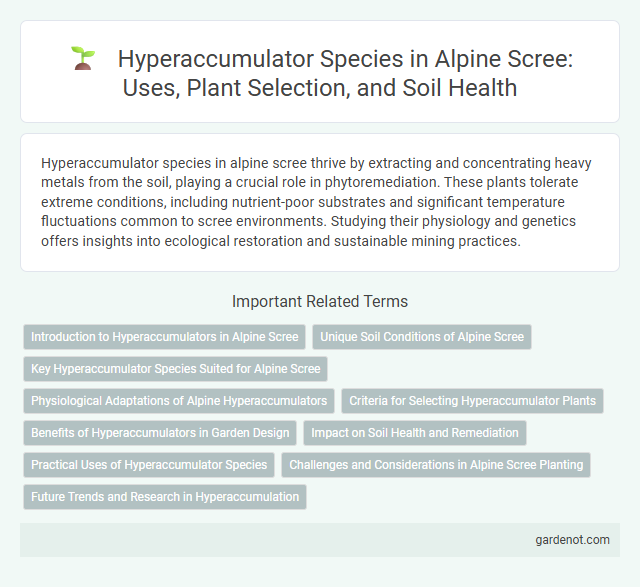Hyperaccumulator species in alpine scree thrive by extracting and concentrating heavy metals from the soil, playing a crucial role in phytoremediation. These plants tolerate extreme conditions, including nutrient-poor substrates and significant temperature fluctuations common to scree environments. Studying their physiology and genetics offers insights into ecological restoration and sustainable mining practices.
Introduction to Hyperaccumulators in Alpine Scree
Hyperaccumulator species in alpine scree environments exhibit unique adaptations that allow them to thrive in metal-rich, nutrient-poor substrates by accumulating exceptionally high levels of heavy metals such as nickel, zinc, and cadmium. These plants facilitate phytoremediation and contribute to the understanding of metal tolerance mechanisms in extreme conditions typical of alpine scree habitats. Research on alpine scree hyperaccumulators enhances ecological restoration strategies and supports biodiversity conservation in mountainous regions.
Unique Soil Conditions of Alpine Scree
Alpine scree hosts unique soil conditions characterized by high mineral content, low organic matter, and rapid drainage, fostering an environment where hyperaccumulator species thrive by selectively absorbing and concentrating metals like nickel, zinc, and cadmium. These plants adapt to the harsh, nutrient-poor substrates by developing specialized root systems and biochemical pathways that enable efficient metal uptake and tolerance. The presence of metalliferous soils in alpine scree promotes biodiversity of hyperaccumulators, contributing to phytoremediation potential and ecosystem metal cycling.
Key Hyperaccumulator Species Suited for Alpine Scree
Key hyperaccumulator species suited for alpine scree include Alyssum murale, known for its exceptional nickel uptake, and Thlaspi caerulescens, which efficiently accumulates zinc and cadmium in metalliferous soils. These plants exhibit adaptations such as wind-resistant root structures and tolerance to extreme temperature fluctuations, enabling survival and metal accumulation on the unstable, rocky substrate typical of alpine scree environments. Their phytoremediation potential is crucial for restoring heavy metal-contaminated alpine scree areas while maintaining ecosystem stability.
Physiological Adaptations of Alpine Hyperaccumulators
Alpine hyperaccumulator species exhibit specialized physiological adaptations such as enhanced metal transport proteins and robust antioxidant systems that mitigate heavy metal toxicity in scree environments. These plants possess root modifications enabling efficient nutrient uptake and metal sequestration despite nutrient-poor, unstable substrates. Their cellular mechanisms include vacuolar compartmentalization and chelation, which facilitate metal accumulation while preventing oxidative stress, ensuring survival in extreme alpine scree habitats.
Criteria for Selecting Hyperaccumulator Plants
Hyperaccumulator plants in alpine scree are selected based on their exceptional ability to concentrate heavy metals such as nickel, zinc, and cadmium from impoverished, rocky soils. Key criteria include the plant's metal tolerance threshold, biomass production capacity, and root system architecture effective for metal uptake in nutrient-poor scree environments. Species like Alyssum murale and Thlaspi caerulescens exemplify these traits, making them prime candidates for phytoremediation in alpine scree habitats.
Benefits of Hyperaccumulators in Garden Design
Hyperaccumulator species in alpine scree environments offer significant benefits for garden design by naturally extracting heavy metals from contaminated soils, promoting healthier plant growth and soil quality. Their ability to thrive in challenging alpine conditions adds unique biodiversity and aesthetic appeal, while reducing the need for chemical soil treatments. Incorporating these plants enhances sustainable landscaping practices and supports ecological restoration efforts.
Impact on Soil Health and Remediation
Hyperaccumulator species in Alpine scree environments significantly enhance soil health by extracting and concentrating heavy metals like zinc, nickel, and cadmium from the substrate, thereby reducing soil toxicity. Their root systems facilitate nutrient cycling and improve soil structure, promoting microbial diversity essential for ecosystem stability. These plants are vital for the phytoremediation of contaminated scree slopes, accelerating the detoxification process and enabling the recovery of degraded alpine soils.
Practical Uses of Hyperaccumulator Species
Hyperaccumulator species found in alpine scree environments are valuable for phytoremediation, as they absorb and concentrate heavy metals like nickel, zinc, and cadmium from contaminated soils. These plants facilitate the extraction of toxic elements, enabling environmental cleanup and soil restoration in mining-impacted areas. Furthermore, hyperaccumulators have potential applications in phytomining, where harvested biomass is processed to recover valuable metals efficiently.
Challenges and Considerations in Alpine Scree Planting
Hyperaccumulator species in alpine scree face challenges such as nutrient-poor substrates and extreme temperature fluctuations, which limit their growth and metal uptake efficiency. Soil instability and minimal organic matter require careful selection of species with strong root systems and tolerance to heavy metal toxicity for successful establishment. Careful consideration of microhabitat conditions and metal bioavailability is essential to optimize phytoremediation and conservation outcomes in these fragile ecosystems.
Future Trends and Research in Hyperaccumulation
Future research in alpine scree hyperaccumulator species is exploring genetic pathways that enhance heavy metal uptake and tolerance, aiming to improve phytoremediation efficiency. Emerging studies focus on the integration of multi-omics approaches to identify novel hyperaccumulating traits and adaptive mechanisms in extreme alpine environments. Advances in biotechnological applications and climate-resilient phenotype selection are expected to drive sustainable remediation strategies for metal-contaminated alpine scree ecosystems.
Hyperaccumulator species Infographic

 gardenot.com
gardenot.com